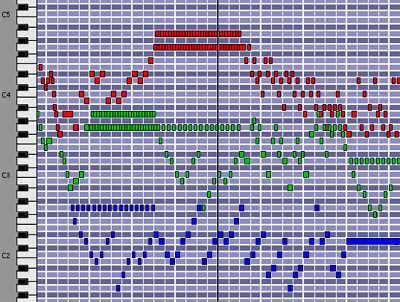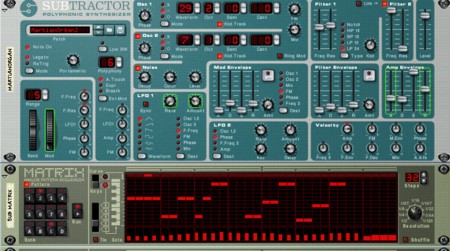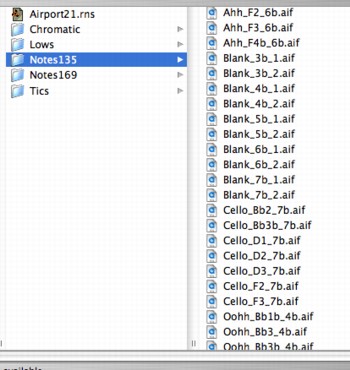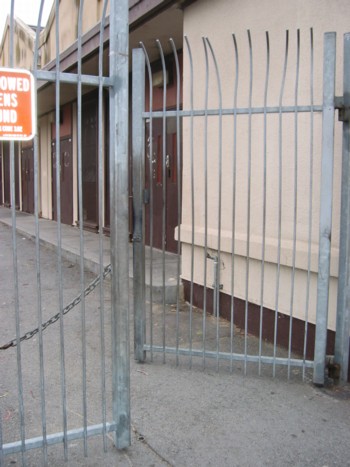Multichannel Ambient Spatialized Music

excerpt from J.S. Bach's Toccata & Fugue in D minor, with musical
lines colored differently. (screenshot from Reason, modified to change colors).
The initial music written for the 8 channel spatialized sound system came from a dark ambient project I was working on, called "Oscura." These were pieces written on a software sequencer (Reason), or recorded and/or in multitrack software. The pieces were originally intended to be mixed down to stereo. For this project, I remixed the existing pieces into 6 or 8 channels, so that the different channels could be placed separately in space.
Some music was written specifically for Heavens Speak, with the intent of having spoken word played over the top.
And then I took a Bach piece and made it multichannel: the grand Toccata and Fugue in D minor. I started with a midi file of the score, and teased out the different lines of the fugue, and a few other runs of notes that looked like they might separate well (e.g. the bass pedal lines), and ran them through pretentious organ samples to come up with 6 sound files that could be placed independently, yet when played together would result in the fugue.
Next I wrote the random composition generator software and music for that. The motivation for writing the random composition generator was that I wanted the system to be able to play for a week without repeating too frequently, and I figured I would need a playlist about 4 hours long. A couple of months before the Burning Man installation, I had about an hour and a half of 8 channel songs composed. And it's quite a process to create more. So I came up with this system to be able to play a piece that sounded similar, but never the same, and could be left running for 10 or 20 minutes at a time.
The first piece written for this system, called "Pickerel Lake," used a set of interlocking note patterns, some staccato, played on vibes, and some long and spacey, on a synthesizer patch. The random sound bits matched up in pulse because they were composed on a software sequencer. With drum patterns, and the occasional recording of birds or a horse mixed in, the song had a fairly simple rhythmic structure.

C major vibraphone pattern from "Pickerel Lake" composition. (screenshot of Reason sequencer).
 Martian Organ synthesizer patch and one of its patterns, from "Pickerel Lake."
(also a screenshot of Reason).
Martian Organ synthesizer patch and one of its patterns, from "Pickerel Lake."
(also a screenshot of Reason).
Harmonically, however, the piece seemed to have several moods. The note patterns each centered around a particular chord. One set of patterns held the I, iii, and V chords (Cmajor, Eminor, Gmajor), while another set held patterns that fit the iii, V, and vi chords (Eminor, GMajor, Aminor). Given the random nature of the system, any of these chords could be played against each other, resulting in interesting chord structures. For example, the I chord (C, E, G) against a V chord (G B D) results in a Cmajor 9th chord. A iii chord (E G B) against a vi chord (A C E) gives an Aminor 9th, and so on. So the chord patterns can read as either of their constituent parts, or as the combined chord, depending on what parts of the patterns are being played and how they interact with each other. With a random element thrown in, this piece will vary its harmonic mood from upbeat and lilting to almost somber.
The next piece I wrote was an homage to the inspiration for this module, Brian Eno's "Music for Airports." One of the pieces on that album consists of long voices coming in and out, with simple ticking or clicking sounds every so often. I wanted a piece that sounded similar, but wasn't a clone.
The idea was to have each set contain sound files that each had a
single note. The sets were arranged so that when voices were played
together, they would hover around a single chord, in this case Bb6/9
(Bb D F G C). Two sets had the 1, 3, and 5 notes (Bb D F), a third set
had the 1, 6, and 9 notes (Bb G C). I used vocal samples that were
long single note choir voices, with a few low notes from a cello
sample. Then a fourth set brought in notes that were not in the Bb6/9
chord, and in some cases were blues notes relative to the Bb
scale. The fourth set had its parameters set to play its notes more
sparsely that the other sets of notes. This results in a harmonic
structure that hovers around the Bb6/9 chord, though only playing a
maximum of three notes at a time out of the 5 note chord, but with
occasional notes thrown in that change the harmony for a brief
period.
 Screenshot of directory of some of the sound files in "Airport 21"
homage composition.
Screenshot of directory of some of the sound files in "Airport 21"
homage composition.

Squeaky gate in the mission district, San Francisco.





